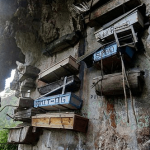 Technology
Technology  Technology
Technology  Humans
Humans 10 Everyday Human Behaviors That Are Actually Survival Instincts
 Animals
Animals 10 Animals That Humiliated and Harmed Historical Leaders
 History
History 10 Most Influential Protests in Modern History
 Creepy
Creepy 10 More Representations of Death from Myth, Legend, and Folktale
 Technology
Technology 10 Scientific Breakthroughs of 2025 That’ll Change Everything
 Our World
Our World 10 Ways Icelandic Culture Makes Other Countries Look Boring
 Misconceptions
Misconceptions 10 Common Misconceptions About the Victorian Era
 Mysteries
Mysteries 10 Strange Unexplained Mysteries of 2025
 Miscellaneous
Miscellaneous 10 of History’s Most Bell-Ringing Finishing Moves
 Technology
Technology Top 10 Everyday Tech Buzzwords That Hide a Darker Past
 Humans
Humans 10 Everyday Human Behaviors That Are Actually Survival Instincts
 Animals
Animals 10 Animals That Humiliated and Harmed Historical Leaders
Who's Behind Listverse?

Jamie Frater
Head Editor
Jamie founded Listverse due to an insatiable desire to share fascinating, obscure, and bizarre facts. He has been a guest speaker on numerous national radio and television stations and is a five time published author.
More About Us History
History 10 Most Influential Protests in Modern History
 Creepy
Creepy 10 More Representations of Death from Myth, Legend, and Folktale
 Technology
Technology 10 Scientific Breakthroughs of 2025 That’ll Change Everything
 Our World
Our World 10 Ways Icelandic Culture Makes Other Countries Look Boring
 Misconceptions
Misconceptions 10 Common Misconceptions About the Victorian Era
 Mysteries
Mysteries 10 Strange Unexplained Mysteries of 2025
 Miscellaneous
Miscellaneous 10 of History’s Most Bell-Ringing Finishing Moves
10 Creepy Rituals Hidden in Ancient Burials
Ancient graves are like time capsules. They can teach us much about extinct cultures, especially which rituals accompanied funerals and sacrifices. In recent years, encounters with long-dead skeletons revealed new mysteries and facts in this regard. From a curious battlefield cleanup to a horrifying ritual that lasted for millennia, here are ten dark practices you might be glad are gone.
Related: The Fascinating History Behind Ten of America’s Oldest Graveyards
10 The Blue String Mystery
About 15 years ago, the Midnight Terror Cave was discovered in Belize. Archaeologists found over 100 people inside who had been sacrificed to the Maya rain god. The bones, which were over a thousand years old, were examined, but it wasn’t until 2022 that a study looked at the teeth.
The idea was to learn more about what they ate. Instead, scientists stumbled upon blue string caught in the calcified plaque of two individuals. Past studies have already revealed that blue was an important color to the Maya and that sometimes, they painted the bodies of their sacrificial victims blue.
It’s impossible to say if anyone inside the cave was painted blue (they were skeletons at this point). Still, the fibers suggested a curious detail. Those chosen as offerings to the rain god might’ve had bright blue cloth stuffed in their mouths before being killed. If so, what was the significance of blue gags? If these weren’t gags, how did the two victims get blue fibers in their teeth? Only more research will tell.[1]
9 Headless Nazca Skeletons
In Peru, the Nazca culture (200 BC to AD 600) famously created a group of mysterious geoglyphs called the Nazca Lines. They left behind another riddle, and it’s not as widely known despite painting a darker story than the Lines. Apparently, this society practiced decapitation.
Learning more about this unusual side of the Nazca isn’t easy. Only a handful of headless skeletons are on record, and they haven’t revealed a lot of information. Then, in 2007, a new headless body was discovered at La Tiza. While it didn’t solve the mystery, the grave dropped a few clues about why the Nazca performed such grisly acts.
Damage to the third vertebrae confirmed that the individual was decapitated alive or right after death. Near the body was a “head jar” (a pot with a picture of a head), and it dated to AD 450 and AD 550 when the La Tiza region was no longer inhabited.
But why bury someone at an abandoned site? Perhaps the deceased was now considered an ancestor and thus returned to an ancestral site. The head jar, something researchers suspect was used in fertility rituals, suggested that the Nazca might’ve believed that decapitation ensured rebirth after death.[2]
8 Companions for the Afterlife
If you were the spouse or servant of a Coclé nobleman, your life depended on his longevity. According to their traditions, when a high-ranking individual died, his favorite wives or slaves (or both) were sacrificed as part of the funeral and placed inside the grave with him. The purpose? To ensure that the deceased wouldn’t be lonely in the afterlife.
The practice of killing off one’s nearest and dearest was seemingly restricted to a certain section of the Rio Grande Valley. In 2011, a tomb was discovered in the region, and it showed just how prolific the sacrifices were during some of these burials.
It contained a young lord who died about 1,200 years ago. His lavish grave was lined with luxury items such as gold artifacts, jewelry, pottery—and the remains of up to 31 other people. Even more spine-chilling, the nobleman was buried face down on top of the body of a woman. While this is super-creepy to a modern mind, it was a normal tradition for the Coclé culture, which thrived in Panama between 200 BC and AD 1550.[3]
7 The Bodies in the Foundation
Founded in 57 BC, South Korea’s Silla dynasty was a powerhouse that ruled for a long time. But it wasn’t all glory and might. Legend told of a gruesome Silla practice, which was to sacrifice a person to ensure the success of a building project. While such stories were interesting, nobody considered the claims to be true, mainly due to a lack of physical evidence.
That was until archaeologists excavated Wolseong Palace, the dynasty’s seat of power. In 2017, the foundation near the main entrance revealed the bodies of a man and a woman, both in their 50s. In 2021, a third person was discovered, a woman in her 20s.
Several things pointed towards a triple sacrifice to bless the building. The three individuals belonged to a lower class, the most likely social strata to be sacrificed. They were also buried in a section that was constructed before other main features. At least one of them, the young woman, was placed there during the fourth century AD, the same time when the palace was being built.[4]
6 A Curious Battlefield Cleanup
The Roman Empire was once a mighty force. However, their historians lamented the fact that it was difficult to conquer Germanic tribes. Thanks to Roman records, we know that these tribes were tough to the point of being barbaric, but nothing is known of this culture’s warring ways before AD 200. For a long time, modern researchers had no idea how large Germanic armies were, how they were organized, or what they did with their fallen warriors.
Then came a game-changing site. Located in Denmark’s Alken Enge wetlands, it was littered with human bones that bore the marks of a battle from the first century AD. This fell nicely into the mysterious period, where almost nothing is known of Germanic warfare. In this case, at least 380 people died. This large number revealed that warriors likely came from several villages, and organizing them into a single army required great organizational skills.
The most fascinating discovery was something the survivors or families did. They visited the battlefield a year later to collect the bones. They severed the ligaments that held the skeletons together, strung pelvises together, and transported all the remains from an unknown battlefield to the wetlands. Plenty of skull fragments suggested that the funerary rituals also included crushing the heads of the deceased.[5]
5 Ritual Violence against Lower Classes
In the Peruvian highlands, there is an archaeological site called Pacopampa. From 2005 to 2015, the site produced over 100 bodies. These individuals were buried between 1,200 and 500 BC and included adults and children.
Seven skeletons were recovered from Pacopampa’s ceremonial platform, and they showed trauma to the head and limbs. While the damage to their arms and legs was determined to be day-to-day mishaps, the skull injuries were less innocent. These people had suffered violent blows to the head, and with no defensive fractures on their arms, it would appear that they never put up a fight.
Since Pacopampa was a ceremonial site, they were likely subjected to ritual harm during ceremonies. It’s unclear if they were willing participants, but signs of healing showed that the injuries didn’t always cause instant death.
The real question is, “Why?” Why deliver devasting blows to somebody’s head? A leading theory suggests class warfare, where the elite asserted their dominance via brutal rituals.[6]
4 4 Infants with Extra Skulls
Between 2014 and 2016, archaeologists found eleven bodies inside funeral mounds in Ecuador. While finding skeletons in graves is not strange, two of the skeletons blew even the experts out of the water. The pair in question were infants, and they wore the skulls of older children, almost like bone “helmets.” This type of mortuary headgear has never been recorded before.
Located in Salango, an ancient ritual complex, the 2,100-year-old site belonged to the Guangala culture. For some reason, when an 18-month-old infant died, the community topped the baby’s head with a cranium that once belonged to a child aged 4 to 12 years. The second infant, who was 6 to 9 months old at the time of death, was buried with a cranium from someone aged 2 to 12 years.
The shocking discovery left many questions. What happened to the other children whose skulls became helmets? Why perform such an unusual ritual? The skull caps could’ve played a protective role in the afterlife, or worse, ash at the site suggests that the four children might have been sacrificed to appease a nearby active volcano.[7]
3 Sacrifices at Germany’s Stonehenge
In 1991, aerial photographers were flying southwest of Berlin, in Germany, when they spotted an ancient structure below. It consisted of seven concentric rings formed by banks and ditches with post holes for wooden poles. Due to its appearance, it was quickly compared to Britain’s Stonehenge monument.
Things took a macabre turn when archaeologists started pulling artifacts from the post holes. The site was used non-stop for about 300 years. When the team reached the oldest layer (2321 to 2211 BC) representing the Bell-Beaker culture, they found pottery shards, animal bones, stone axes—and 10 women and children.
The bodies showed alarming signs of maltreatment, such as dismemberment, bound hands, and fractured skulls and ribs. They had also been tossed into the shafts. In stark contrast, nearby graves held 13 men buried in a dignified manner with no physical trauma. This difference suggests that the men were buried near the enclosure to honor them while the women and children were ritually murdered for reasons yet unknown.[8]
2 A Mass Sacrifice to Fight Floods
In 2018, National Geographic broke a horrific story. Two mass graves were discovered near Chan Chan, the ancient capital of the Chimú people. Around 1415, both locations bore witness to a ritual so bloody and unthinkable that it quickly spread across the modern news circuit.
Around 269 children and 466 llamas were led to the sites and sacrificed. Most of the victims were dispatched with a cut to the chest. The efficiency of the killings testified to the presence of an expert executioner. Ironically, he might even have been one of the victims. Two women and a man were also found, likely killed when their roles in the slaughter were completed.
The weather might’ve triggered the brutal sacrifice. During this time, so much rain fell across the normally arid coast of northern Peru that it likely destroyed the Chimú’s crops, causing them to starve. Adding to their problems was the Inca, who were busy taking over their civilization. Either or both events could’ve prompted the Chimú to barter for better fortunes by giving the gods their most valuable commodities—their children and llamas.[9]
1 Terrifying Ritual Murder across Europe
During the 1980s, the remains of three women were found in the Rhône Valley in France. The skeletons, roughly 6,000 years old, were stuffed into a fake food storage pit in the ground. Why the community chose to bury them in a “larder” might never be known, but the food connection suggested a sacrifice to manifest agricultural success.
The positions of two of the individuals were suspicious. Their ankles appeared bound and tied to their necks in such a way that the women were forced to strangle themselves. Their chests were also twisted and compressed, clear signs that they were buried alive and purposefully positioned to perish from asphyxiation.
Further research uncovered similar burials at 14 different sites in Europe, and the victims included men, women, and children. Apart from being a widespread ritual, this gruesome practice also endured for far too long. The ages of the skeletons proved that their communities committed these bizarre ritual murders for over 2,000 years.[10]








